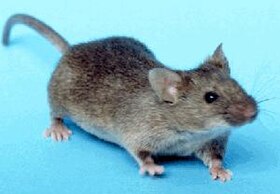Murinae
Aspect
| Murinae Fosilă:Miocenmijlociu - prezent | |
|---|---|

| |
| Mus musculus | |
| Clasificare științifică | |
| Regn: | Animalia |
| Încrengătură: | Chordata |
| Clasă: | Mammalia |
| Ordin: | Rodentia |
| Suprafamilie: | Muroidea |
| Familie: | Muridae |
| Subfamilie: | Murinae Illiger,1811 |
| Genuri | |
|
vezi textul | |
| Modificătext |
|
Murinaeeste osubfamiliederozătoaredinfamiliaMuridae,care cuprinde 129 de genuri și 584 de specii. Această subfamilie este mai numeroasă decât orice familie demamiferecu excepțiaCricetidaeșiMuridae,și, mai numeroasă decât oriceordindemamiferecu excepțialiliecilorși arozătoarelor.
Lista genurilor
[modificare|modificare sursă]Subfamilia Murinae
- Grupul Aethomys
- GenulAethomys
- GenulMicaleamys
- Grupul Apodemus
- Grupul Arvicanthis
- GenulArvicanthis
- GenulDesmomys
- GenulLemniscomys
- GenulMylomys
- GenulPelomys
- GenulRhabdomys
- Grupul Chrotomys
- GenulApomys
- GenulArchboldomys
- GenulChrotomys
- GenulRhynchomys
- Grupul Colomys
- GenulColomys
- GenulNilopegamys
- GenulZelotomys
- Grupul Crunomys
- GenulCrunomys
- GenulSommeromys
- Grupul Dacnomys
- GenulAnonymomys
- GenulChiromyscus
- GenulDacnomys
- GenulLeopoldamys
- GenulNiviventer
- GenulSaxatilomys
- GenulSrilankamys
- Grupul Dasymys
- GenulDasymys
- Grupul Echiothrix
- GenulEchiothrix
- Grupul Golunda
- GenulGolunda
- Grupul Hadromys
- GenulHadromys
- Grupul Hybomys
- Grupul Hydromys
- GenulCrossomys
- GenulHydromys
- GenulMicrohydromys
- GenulParahydromys
- GenulParaleptomys
- Grupul Lorentzimys
- GenulLorentzimys
- Grupul Malacomys
- GenulMalacomys
- Grupul Maxomys
- GenulMaxomys
- Grupul Melasmothrix
- GenulMelasmothrix
- GenulTateomys
- Grupul Micromys
- GenulChiropodomys
- GenulHaeromys
- GenulHapalomys
- GenulMicromys
- GenulVandeleuria
- GenulVernaya
- Grupul Millardia
- Grupul Mus
- Grupul Oenomys
- GenulCanariomys
- GenulGrammomys
- GenulLamottemys
- GenulMalpaisomys
- GenulOenomys
- GenulThallomys
- GenulThamnomys
- Grupul Phloeomys
- GenulBatomys
- GenulCarpomys
- GenulCrateromys
- GenulPhloeomys
- Grupul Pithecheir
- GenulEropeplus
- GenulLenomys
- GenulLenothrix
- GenulMargaretamys
- GenulPithecheir
- GenulPithecheirops
- Grupul Pogonomys
- GenulAbeomelomys
- GenulAnisomys
- GenulChiruromys
- GenulCoccymys
- GenulCoryphomys
- GenulHyomys
- GenulMacruromys
- GenulMallomys
- GenulMammelomys
- GenulPogonomelomys
- GenulPogonomys
- GenulSpelaeomys
- GenulXenuromys
- Grupul Pseudomys
- GenulConilurus
- GenulLeggadina
- GenulLeporillus
- GenulMastacomys
- GenulMesembriomys
- GenulNotomys
- GenulPseudomys
- GenulZyzomys
- Grupul Rattus
- GenulAbditomys
- GenulBandicota
- GenulBerylmys
- GenulBullimus
- GenulBunomys
- GenulDiplothrix
- GenulHalmaheramys[1]
- GenulKadarsanomys
- GenulKomodomys
- GenulLimnomys
- GenulNesokia
- GenulNesoromys
- GenulPalawanomys
- GenulPapagomys
- GenulParuromys
- GenulPaulamys
- GenulRattus
- GenulSundamys
- GenulTaeromys
- GenulTarsomys
- GenulTryphomys
- Grupul Stenocephalomys
- GenulHeimyscus
- GenulHylomyscus
- GenulMastomys
- GenulMyomyscus
- GenulPraomys
- GenulStenocephalemys
- Grupul Uromys
- GenulMelomys
- GenulParamelomys
- GenulProtochromys
- GenulSolomys
- GenulUromys
- Grupul Xeromys
- GenulLeptomys
- GenulPseudohydromys
- GenulXeromys
- Grupul Otomyines
În 2012 a fost descris genulPaucidentomys.[2]
Referințe
[modificare|modificare sursă]- ^Fabre, P.-H.; Pagès, M.; Musser, G. G.; Fitriana, Y. S.; Fjeldså, J.; Jennings, A.; Jønsson, K. A.; Kennedy, J.; Michaux, J.; Semiadi, G.; Supriatna, N.; Helgen, K. M. (),„A new genus of rodent from Wallacea (Rodentia: Muridae: Murinae: Rattini), and its implication for biogeography and Indo-Pacific Rattini systematics”,Zoological Journal of the Linnean Society,169(2): 408–447,doi:10.1111/zoj.12061
- ^Esselstyn, J.A., Achmadi, A.S. Rowe, K.C. (2012). Evolutionary novelty in a rat with no molars. Biology Letters, published online 22 august 2012,doi:10.1098/rsbl.2012.0574
Bibliografie
[modificare|modificare sursă]- Chevret, P., C. Denys, J.-J. Jaeger, J. Michaux, and F.M. Catzeflis. 1993. Molecular evidence that the spiny mouse (Acomys) is more closely related to gerbils (Gerbillinae) than to the true mice (Murinae). Proceedings of the National Academy of Sciences USA, 90:3433-3436.
- Heaney, L., Balete, D., Rickart, E., Alviola, P., Duya, M., Duya, M., Veluz, M., VandeVrede, L., & Steppan, S. (2011). Chapter 1: Seven New Species and a New Subgenus of Forest Mice (Rodentia: Muridae: Apomys) from Luzon Island Fieldiana Life and Earth Sciences, 2, 1-60doi:10.3158/2158-5520-2.1.1
- Jacobs, L.L. 1978. Fossil rodents (Rhizomyinae|Rhizomyidae and Muridae) from Neogene Siwalik deposits, Pakistan. Bulletin of the Museum of Northern Arizona, 52: 1-103.
- Jansa, S., F. K. Barker, and L. R. Heaney. 2006. The pattern and timing of diversification of Philippine endemic rodents: evidence from mitochondrial and nuclear gene sequences. Systematic Biology, 55:73-88.
- Jansa, S.A. and M. Weksler. Phylogeny of Muroidea|muroid rodents: relationships within and among major lineages as determined by IRBP gene sequences. Molecular Phylogenetics and Evolution, 31:256-276.
- McKenna, M.C. and S. K. Bell. 1997. Classification of mammals above the Species Level. Columbia University Press, New York.
- Michaux, J., A. Reyes, and F. Catzeflis. 2001. Evolutionary history of the most speciose mammals: molecular phylogeny of Muroidea|muroid rodents. Molecular Biology and Evolution, 17:280-293.
- Musser, G.G. and M. D. Carleton. 1993. Family Muridae. pp. 501–755 in mammal Species of the World a Taxonomic and Geographic Reference. D.E. Wilson and D.M. Reeder eds. Smithsonian Institution Press, Washington D.C.
- Musser, G. G. and L. R. Heaney. 2006. Philippine rodents: Definitions ofTarsomysandLimnomysplus a preliminary assessment of phylogenetic patterns among native Philippine murines (Murinae, Muridae). Bulletin of the American Museum of Natural History, 211:1–138.
- Nowak, R.M. 1999. Walker's mammals of the World, Vol. 2. Johns Hopkins University Press, London.
- Steppan, S.J., R.A. Adkins, and J. Anderson. 2004. Phylogeny and divergence date estimates of rapid radiations in muroid rodents based on multiple nuclear genes. Systematic Biology, 53:533-553.
- Steppan, S. J., R. M. Adkins, P. Q. Spinks, and C. Hale. 2005. Multigene phylogeny of the Old World mice, Murinae, reveals distinct geographic lineages and the declining utility of mitochondrial genes compared to nuclear genes. Molecular Phylogenetics and Evolution, 37:370-388.
Legături externe
[modificare|modificare sursă]- Murinaeen"Fauna ibérica; mamíferos".Ángel Cabrera Latorre.1914
- Las ratasen la tradiciónhindúen


